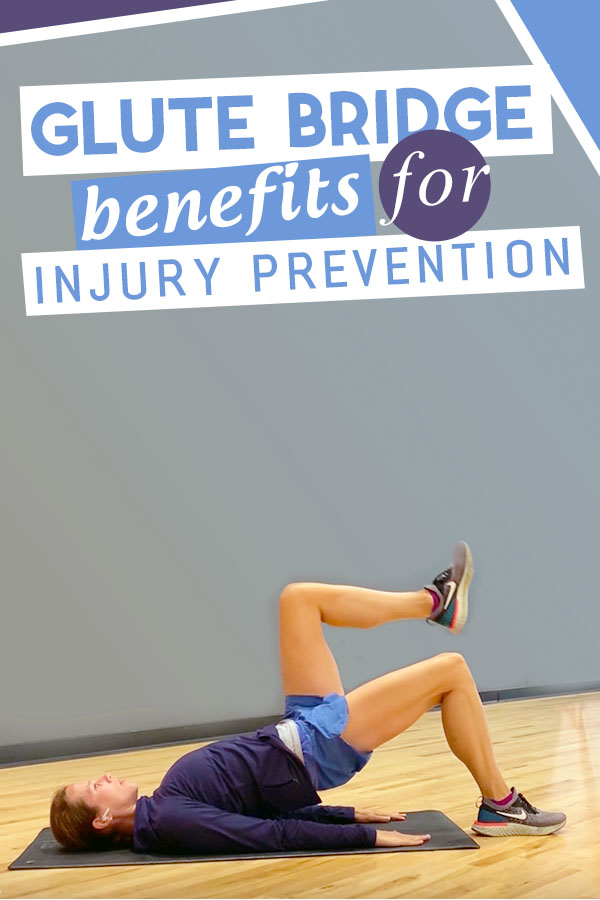Glute bridges are the basic exercise we’ve all seen, maybe thanks to yoga, maybe from an unfortunate trip to the physical therapist, but then we assume it’s too basic to KEEP DOING.
BZZZZ wrong!!
I’m not sure why we think basic is bad, but in this case it’s one of the best exercises runners can be doing to keep from having knee pain, IT Band pain or a host of other injuries.
I know it’s not as sexy as the squat, but listen you get to lay on the ground and get results. I mean that sounds like a great pre or post run moment to me.
What Does the Glute Bridge Do?
Glute bridge benefits are extensive, but specifically when it comes to running:
- Hip flexors get shorter from sitting which makes them tight, which pulls your pelvis forward. That leads to poor posture and weird running form.
- Activates all your core stabilizer muscles, those deep muscles for good form while running
- Increases your glute strength which means more power in your running stride
- Activates your gluteus maximus and gluteus medius, which can mean less knee pain because you hold your form better
- Can help with lower back pain while running
- Great at the end of a abs workout to release any low back pain from tightening the core
Try adding bridges in to your dynamic warm up or do a set during any strength training workout.
What is the Glute Bridge?
The key with any movement is to perform it correctly. So before we move in to any variations, let’s make sure you are correctly working through the range of motion and stability of the basics.
Also known as a hip bridge, this movement is simple, which doesn’t mean easy! It’s going to engage your butt muscles, your hips, your lower back muscles (your entire torso), which is what makes it such an all star movement.
- Starting position is lying on your back, knees bent with feet on the floor.
- Reach your hands down so your heels touch your finger tips to gauge how far from your bum feet should be.
- Pressing your full foot in to the floor
- Raise your hips and thighs in to a straight line with your head
- Make sure your core is engaged and pause
- Make sure that neither side is dropped
- Make sure you aren’t over extending and arching your back
- Make sure you aren’t letting your hips drop down towards the ground
- Then you’ll lower back down to the mat and pause again
If you’re feeling this in your calves then you are pressing too much with the forefoot or raising up on to your toes. That’s not the goal of this lower-body exercise.
As Physical Therapists often remind us, we are working on controlled movements to recruit the right muscles.
This is a stellar glute activation movement!
Start by simply holding that bridge for 30 seconds. Work up to holding for 1 minute. Then start working up to raising and lowering while maintaining good position.
You may NOT feel your glute muscles burning right away. But you want to pay attention to if you feel like your hamstrings or quads are taking over and trying to do the majority of the work.
Glute Bridge Variations
Per usual I like to make sure you know the why to help you stick with it. Now that we have that in place, which types of glute bridges are going to maximize results.
The truth is all of them work, but I love adding in variety because it helps me to feel it in different ways. In fact, the glute bridge march really fires up my core and is often part of my normal dynamic warm up now.
In the following video, I’ve demonstrated a variety of bridge exercises for you.
You’ll see in this video that you can take the bridge to a variety of levels depending on where you are currently.
A few glute bridge exercises I love, these allow you to progress over time:
- Small marching bridge (really feel the core)
- Big marching bridge (really practicing pelvis stabilization)
- Single-leg glute bridge (more easily identify imbalances or weakness on one side)
- Glute bridge on the stability ball or bench
If in doing these you notice one side is weaker, continue doing reps on both sides, but add a few more to the weak side. This will ensure you continue building strength, but give the weaker side a big more work.
The core stability created from these moves makes them ideal as part of your dynamic warm up, not just a stand alone workout routine.
How Long Should I Do Glute Bridges?
The number of repetitions and sets you should do depends on your fitness level and goals. A general rule of thumb is to aim for 2-3 sets of 10-15 repetitions, 2-3 times per week.
However, if you are a beginner, it is important to start slowly and gradually increase the number of repetitions and sets as your strength and endurance improve. It’s also important to focus on proper form and technique to avoid injury.
Are Glute Bridges Safe?
When done correctly, glute bridges are safe for most people who exercise and, as previously stated, can help prevent injury by improving hip strength. Still, there are several things you can do to make sure that you’re performing the exercise correctly and safely.
For starters, make sure you maintain good spinal alignment during the movement. Your body should form a straight line from your hips to the top of your head.
Plus, make sure you don’t over-arch your back, which can cause strain. To avoid this, make sure you’re forcing your lower back into the floor and activating your core as if doing a crunch during the exercise.
If you’re not experiencing the glute bridge exercise in your glutes say, hamstrings, try adjusting your foot placement. The closer your feet are to your butt, the more movement you should feel in your butt. The more they’re away, the more you’ll feel it in your hamstrings.
What About the Glute Bridge vs Hip Thrust?
One of the reasons, I tend to stick to the glute bridge is that I find people can do it more correctly and thus engage the appropriate muscles.
With the hip thrust, I see people doing all kinds of things that are going to hurt their lower back or just aren’t actually activating anything because they’re focused on hitting a certain weight.
Here’s a great video on how to do it correctly.
When done right you are getting a definite booty building strength workout from those thrusters, while the glute bridge is doing to work on stabilizers and propel our runs…it may not be helping you to add a lot of muscle for that rounded bum.
Additionally since it only require bodyweight to hold a bridged position, it’s less intimidating and you’re more likely to do it.
Barbell Hip Bridge
That being said, I’m also a fan of a barbell glute bridge, which I didn’t include in the video.
You can simply hold a dumbbell (or barbell) on your pelvis, while engaging the core and glutes to raise up to a standard bridge and then slowly lower down. This may be done on the floor or you’ll commonly see people place their upper back on a bench for the hip thrust.
Again, you need to really pay attention to not letting one side drop.
Starting with a great bodyweight exercise like the glute bridge is a safe way to begin working all the muscle groups in your core. Once you’ve mastered this, you can begin adding more complex movements like weighted lunges, deadlifts or weighted step ups.
Progress starts with just doing one thing!
Looking for more hip and glute work?
- Glute Stretches for Runners
- 8 Week Progressive Bodyweight Challenge for Runners
- 30 Day Core Challenge for Runners
- Mini Band workout for hips and glutes
- Mobility for tight runner hips
Other ways to connect with Amanda
Instagram Daily Fun: RunToTheFinish
Facebook Community Chatter: RunToTheFinish
Sign Up to Receive a Weekly Newsletter with Top Running Tips and Laughs



 Knee Pain After Running: 7 Common Causes And Treatments
Knee Pain After Running: 7 Common Causes And Treatments